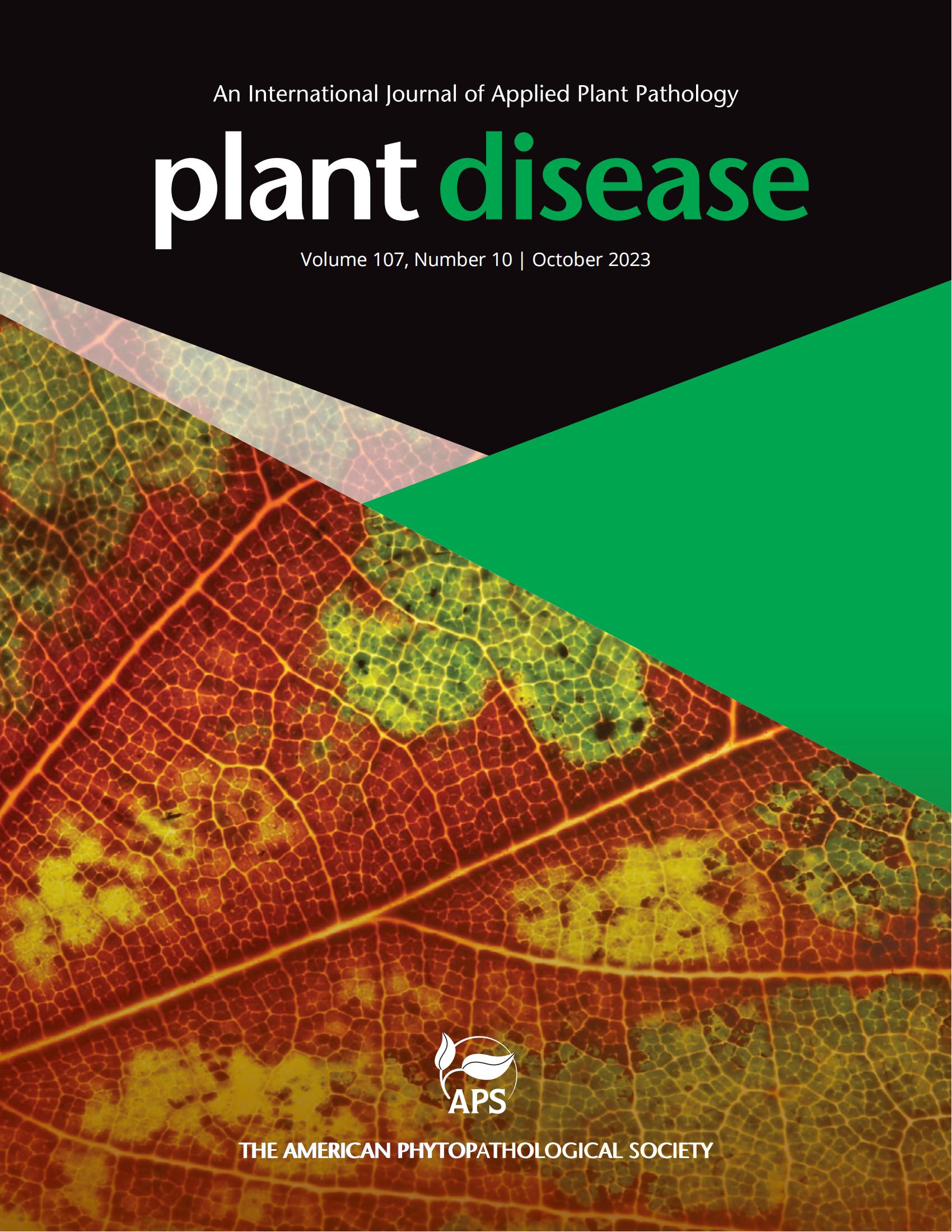尖孢镰刀菌引起紫苏枯萎病国内首次报道。
摘要
紫苏(Perilla frutescens),俗称“紫苏”,是一种草本植物,以其烹饪和药用特性而闻名,分布在中国各地(Igarashi和Miyazaki, 2013)。2023年10月,在福建省邵武(27.34°N, 117.49°E)地区,发现了黄萎病症状(发病率30%)。茎先是变色,从绿色变成深棕色或黑色。叶子下垂,经常卷曲,最终干枯。随机选择15个典型症状茎,从病变边缘取标本,切成5 × 5-mm片。样品用5%次氯酸钠溶液表面消毒1 min,用无菌水冲洗3次,晾干。样品在马铃薯葡萄糖琼脂(PDA)培养基上25°C黑暗孵育5 d,然后使用单孢子分离转移到新的PDA板上,25°C黑暗孵育5 d。20株分离菌中有13株菌落形态相似(分离率65%)。菌落正面呈扁平、棉质纹理。殖民地的反面是淡黄色的。以康乃馨叶琼脂(CLA)培养基为培养基,培养了两株具有代表性的菌株1380和1383。菌株的微分生孢子大小为5.56 ~ 15.26 μm × 2.82 ~ 4.49 μm (n = 50),呈椭圆形、圆柱形或卵形。大分生孢子有2 ~ 5个间隔,通常为3个间隔,呈直线或微弯曲,尺寸为2.6 ~ 5.47 × 20.8 ~ 42.4 μm (n = 50)。衣原体孢子呈圆形、顶生或间生。形态特征与镰刀菌描述一致(Leslie and Summerell 2006)。采用十六烷基三甲基溴化铵(CTAB)法提取两株分离菌的DNA。部分内部转录间隔区(ITS)、翻译延伸因子(TEF-1α)和部分RNA聚合酶第二大亚基(RPB2)被扩增(TEF-1α的GenBank登录号分别为PV057161和PV057162, RBP2的登录号分别为PV057159和PV057160, ITS的登录号分别为PV639174和PV639175,分别为1380和1383)(Crous et al 2009)。与GenBank中其他镰刀菌的相似度分别为99.85% (TEF-1α, MN417200)、99.90% (RBP2, AB986568)和100% (ITS, OR753367)。利用MEGA6和最大似然法(Xu et al 2022)构建了ITS、TEF-1α和RPB2的系统发育树(Xu et al 2022),两个分离株与尖孢镰刀菌(F. oxysporum)聚类,bootstrap值为99%。以1 × 106个分生孢子/mL浓度的1383分生孢子悬浮液喷施于3个月龄木香幼苗的茎上,研究其致病性。作为对照,在2个对照茎上喷洒无菌水,3个生物重复。幼苗用塑料薄膜覆盖24 h,在25℃培养室内保存,接种后4 d,接种茎表现出与田间相似的症状,而对照茎无症状。科赫的假设是通过根据形态特征从患病茎中重新分离出相同的分离物来实现的。形态学和分子生物学结果证实分离菌株为尖孢镰刀菌。这是第一次报道尖孢镰刀菌引起西瓜枯萎病。中国是果霉的主要种植国和出口国,该病害对生产构成威胁和危害。由于尖孢镰刀菌寄主范围广,应制定相应的防治策略。Perilla frutescens, commonly known as "ZI SU", is an herbaceous plant known for its culinary and medicinal properties and is distributed throughout China (Igarashi and Miyazaki, 2013). In October 2023, wilt symptoms were observed on P. frutescens plants in Shaowu (27.34°N, 117.49°E), Fujian province, China (incidence rate: 30%). The stems first showed discoloration, which transitioned from green to dark brown or black. The leaves drooped and often curled, eventually drying out. Fifteen typical symptomatic stems were randomly selected and samples were taken from the margins of the lesions and cut into 5 × 5-mm pieces. The samples were surface sterilized with 5% sodium hypochlorite solution for 1 min, rinsed with sterile water three times, and dried. Samples were incubated on potato dextrose agar (PDA) medium for 5 d at 25°C in the dark, then transferred using monospore isolation to new PDA plates and incubated for another 5 d at 25°C in the dark. Thirteen of the 20 isolates obtained had similar colony morphology (isolation rate 65%). The front of colonies exhibited a flat, cottony texture. The reverse side of the colonies was pale yellow. Two representative isolates, 1380 and 1383, were cultivated on carnation leaf agar (CLA) medium. Microconidia of the isolates were oval, cylindrical or ovate, and were 5.56 to 15.26 × 2.82 to 4.49 μm (n = 50). Macroconidia had 2 to 5 septa, usually 3 septa, and were straight or slightly curved, 2.6 to 5.47 × 20.8 to 42.4 μm (n = 50). Chlamydospores were roundish, terminal or intercalary. The morphological characteristics were consistent with the description of Fusarium (Leslie and Summerell 2006). DNA was extracted from the two isolates using the cetyltrimethylammonium bromide (CTAB) method. The partial internal transcribed spacer (ITS) region, the translation elongation factor (TEF-1α) and partial RNA polymerase second largest subunit (RPB2), were amplified (GenBank accession numbers for TEF-1α were PV057161 and PV057162, for RBP2 were PV057159 and PV057160, and for ITS were PV639174 and PV639175 for 1380 and 1383, respectively) (Crous et al 2009). When compared with other Fusarium species in GenBank, both isolates exhibited 99.85% (TEF-1α, MN417200), 99.90% (RBP2, AB986568), and 100% (ITS, OR753367) similarity with Fusarium oxysporum. A phylogenetic tree which combined ITS, TEF-1α and RPB2 was constructed using MEGA6 with the maximum likelihood method (Xu et al 2022), and the two isolates clustered with F. oxysporum with 99% bootstrap values. To test pathogenicity, a conidial suspension of 1383 with a concentration of 1 × 106 conidia/mL was sprayed on three stems of one-month-old P. frutescens seedlings. For the control, sterile water was sprayed on two control stems and there were 3 biological replicates. Seedlings were covered with plastic film for 24 h and kept in a culture room at 25°C, and inoculated stems exhibited similar symptoms to those in the field 4 days' post inoculation, while control stems had no symptoms. Koch's postulates were fulfilled by reisolating the same isolate from diseased stems based on morphological characteristics. The morphology and molecular biology results confirm that the isolates were F. oxysporum. This is the first report of F. oxysporum causing wilt on P. frutescens. China is the main cultivation and export country of P. frutescens, and this disease poses a threat and damage to production. Since F. oxysporum has a wide host range, strategies to manage it should be developed.

 求助内容:
求助内容: 应助结果提醒方式:
应助结果提醒方式:


